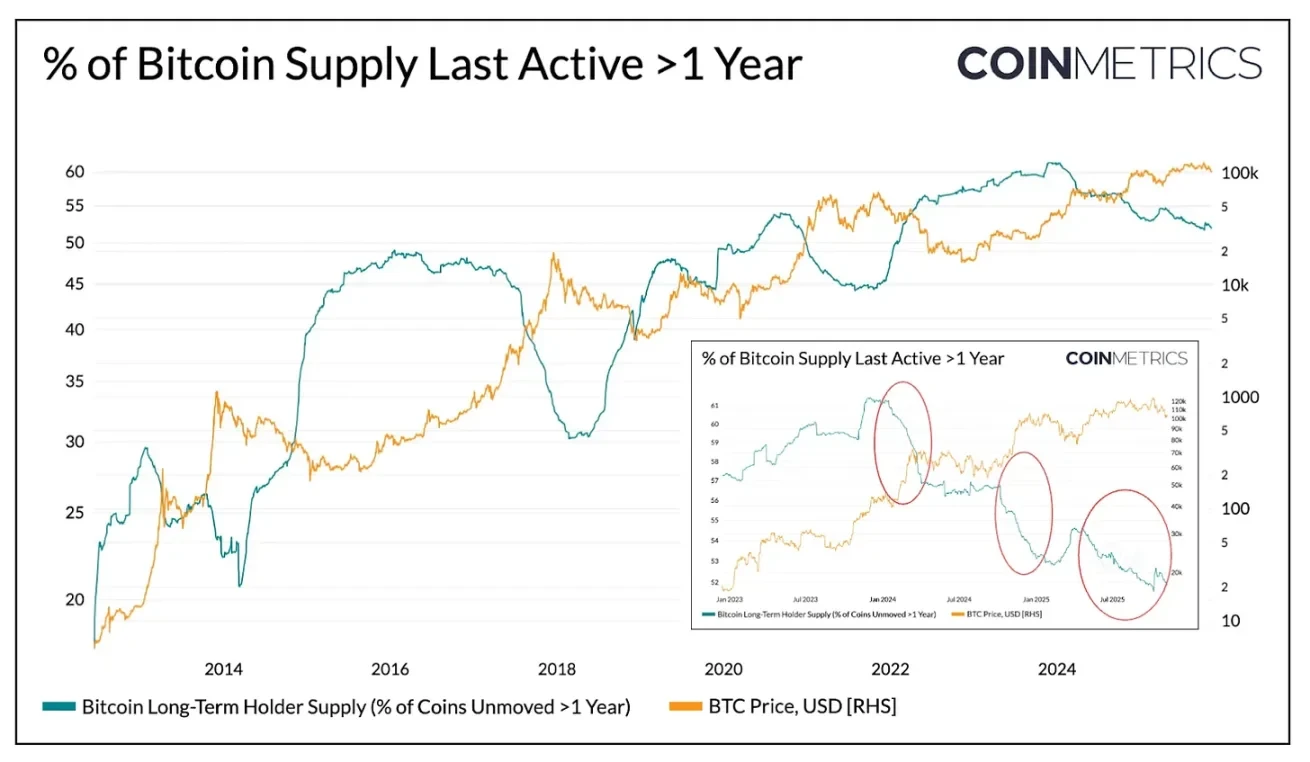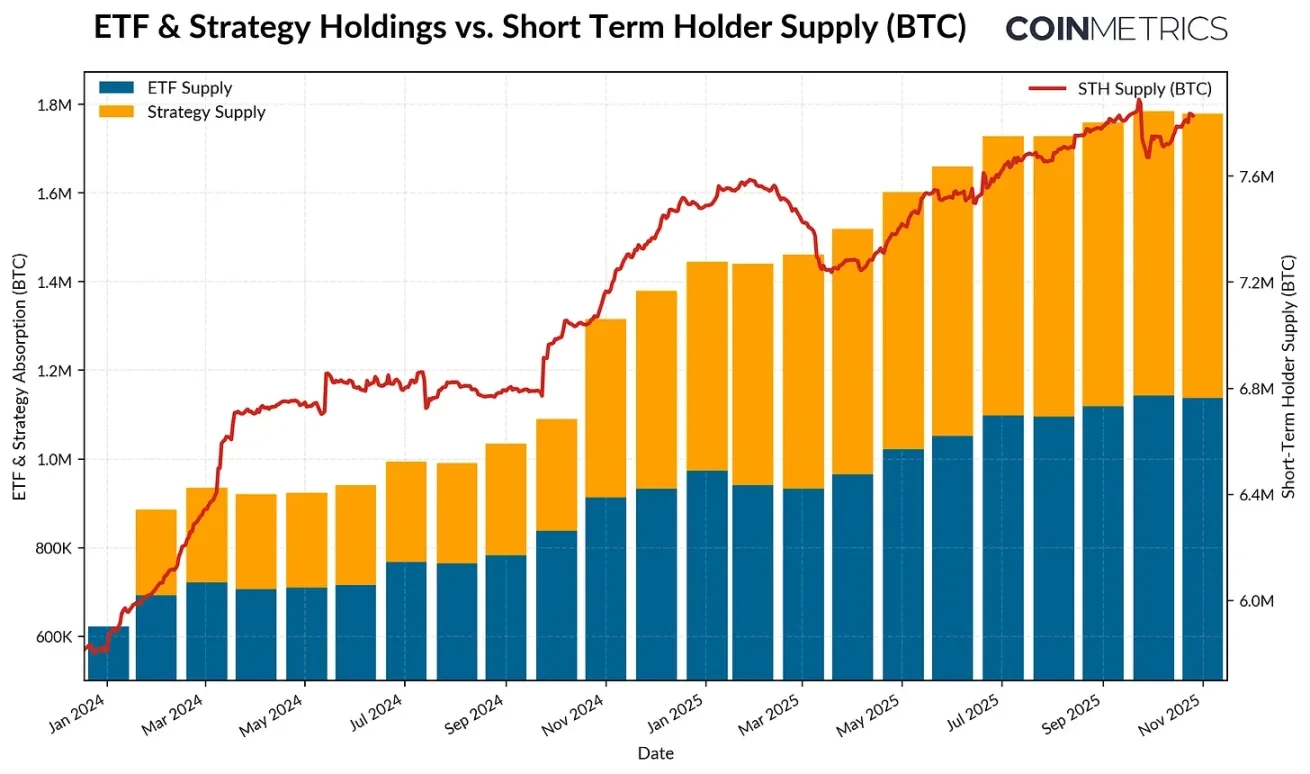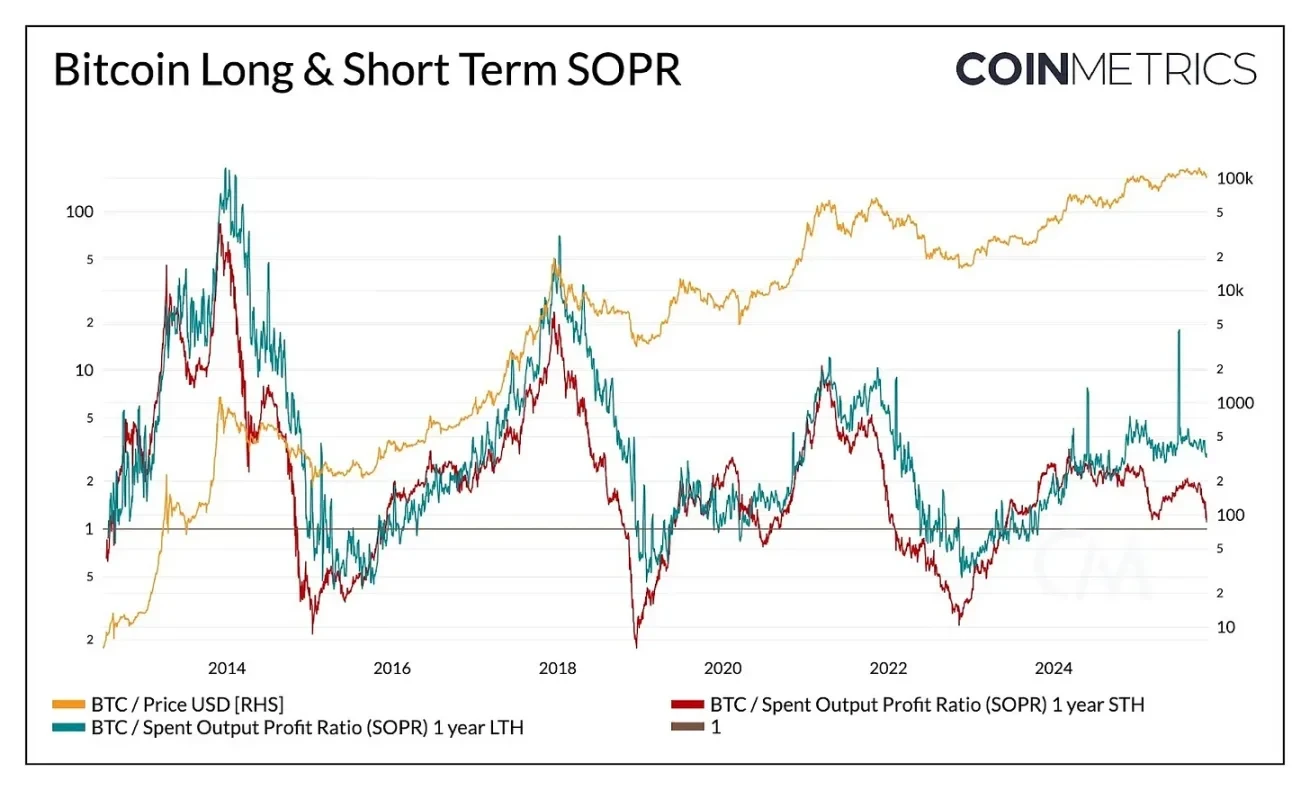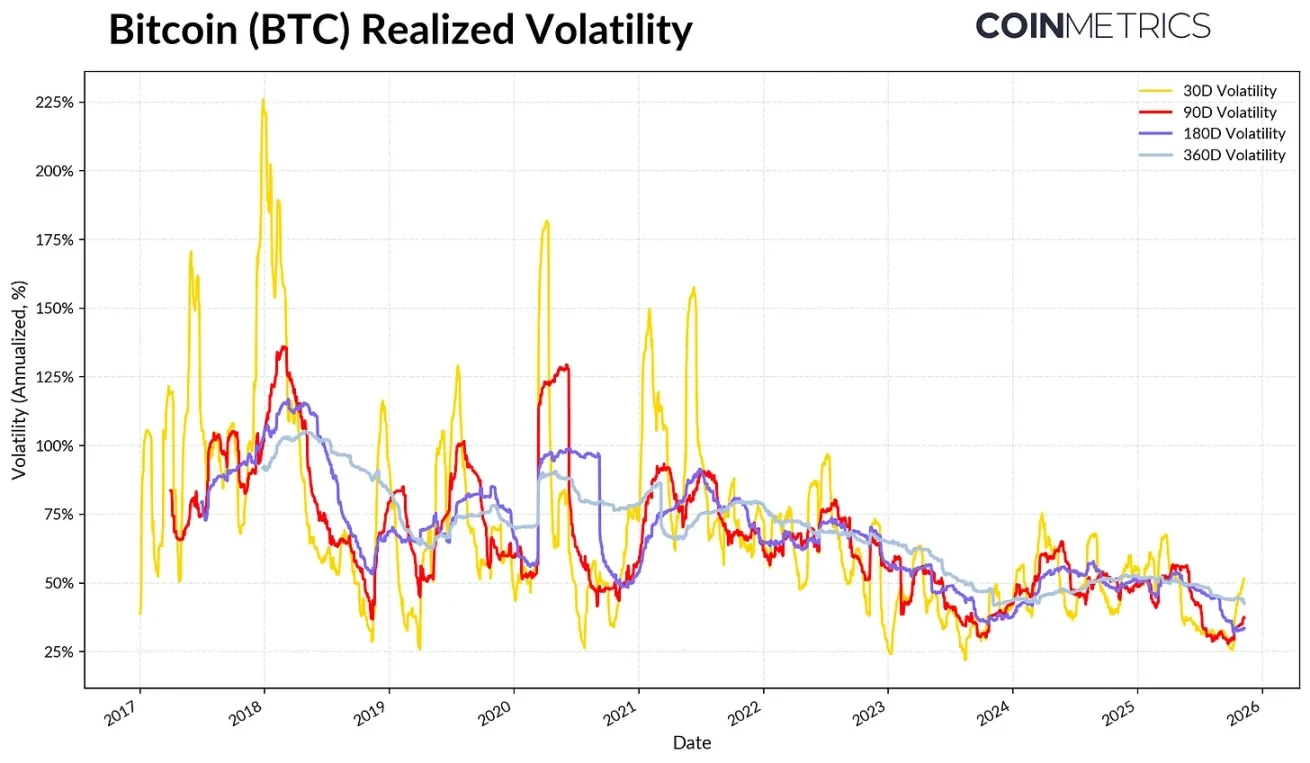Why has this Bitcoin cycle been prolonged?
Original author: Tanay Ved
Original translation by Luffy, Foresight News
TL;TR
- As long-term holders sell in batches and new participants take over the supply, the turnover rate of Bitcoin's supply gradually slows down, resulting in a smoother transfer of ownership.
- Since the beginning of 2024, spot Bitcoin ETFs and crypto treasuries (DAT) alone have absorbed about 57% of the increase in supply from short-term holders, and now account for nearly a quarter of the total circulating Bitcoin over the past year.
- The continued stabilization of actual volatility indicates that the market structure is maturing, characterized by institutional demand dominating and a longer cycle.
After hitting an all-time high earlier this year, Bitcoin has largely been consolidating, briefly dipping below the $100,000 mark for the first time since June. Macroeconomic headwinds, a weak stock market, and a rare series of cryptocurrency liquidations have collectively dampened market sentiment, slowed capital inflows, and raised questions about the sustainability of the Bitcoin bull market. Furthermore, growing concerns about large holders transferring or selling early positions are putting pressure on Bitcoin and the overall cryptocurrency market. Following the recent decline, the current total market capitalization of cryptocurrencies is approximately $3.6 trillion.
Beyond the surface phenomena, Bitcoin's on-chain data provides crucial context. In this article, we will explore how changes in Bitcoin holder behavior and core demand drivers influence market sentiment and define the rhythm of this cycle. By analyzing changes in active supply and demand channels, we will investigate whether recent market volatility signals end-of-cycle profit-taking or a structural shift in Bitcoin ownership.
Supply distribution and institutional undertaking
Active supply
First, let's look at Bitcoin's active supply. This metric is divided by "time since the last on-chain move" and reflects the flow of tokens held for different years. It can clearly show the distribution of supply between "dormant tokens" and "recently moved tokens".
The chart below separately lists the percentage of Bitcoin supply held for more than a year without moving. This data can be used as a proxy indicator of the holdings of long-term holders (LTH). Historically, this percentage tends to rise during bear markets (as tokens concentrate in the hands of long-term holders) and fall during bull markets (as long-term holders begin moving their tokens, taking profits, and selling at higher prices).

Data source: Coin Metrics Network Data Pro
As of now, of the 19.94 million circulating Bitcoins, approximately 52% have remained unmoved for over a year, down from 61% at the beginning of 2024. Both the rate of increase during bear markets and the rate of decrease during bull markets have noticeably leveled off. Phased selling occurred in Q1 2024, Q3 2024, and recently in 2025. This indicates that long-term holders are selling their tokens in a more consistent manner, reflecting a lengthening cycle of ownership transfer.
ETFs and DAT: Core Drivers of Demand
Conversely, since 2024, the supply from short-term holders (tokens active over the past year) has steadily increased as previously dormant tokens have re-entered circulation. Simultaneously, the launch of spot Bitcoin ETFs and the accelerated accumulation of Crypto Treasury (DAT) tokens have created new and sustained demand, absorbing the supply distributed by long-term holders.
As of November 2025, the number of active Bitcoins over the past year was 7.83 million, an increase of approximately 34% from 5.86 million at the beginning of 2024 (dormant tokens recirculated). During the same period, holdings in spot Bitcoin ETFs and Strategy's treasury increased from approximately 600,000 Bitcoins to 1.9 million, absorbing nearly 57% of the net increase in supply from short-term holders. Currently, these two channels together account for approximately 23% of the supply from short-term holders.
Although capital inflows have slowed in recent weeks, the overall trend shows that supply is gradually shifting to more stable, long-term holding channels, which is a unique feature of the market structure in this cycle.

Data source: Coin Metrics Network Data Pro & Bitbo Treasuries; Note: ETF supply excludes Fidelity FBTC, DAT supply includes Strategy.
Short-term and long-term holder behavior
Actual profit trends further confirm the flat nature of Bitcoin's supply dynamics. The Spent Output Profit Ratio (SOPR) measures whether holders sell tokens at a profit or loss, clearly reflecting the behavioral patterns of different holder groups throughout market cycles.
In the past, the profit and loss realization of long-term and short-term holders often exhibited sharp and synchronous fluctuations. However, recently, this relationship has diverged: long-term holders' SOPR remains slightly above 1, indicating that they are steadily realizing profits and moderately selling at higher prices.

Data source: Coin Metrics Network Data Pro
Short-term holders' SOPR hovers near the break-even point, which explains the recent cautious market sentiment, as many short-term holders' positions are close to their cost price. This divergence in behavior between the two types of holders reflects a more leveling market phase: institutional demand is absorbing the supply from long-term holders, rather than a return to the sharp fluctuations of the past. If the short-term holders' SOPR continues to break above 1, it could indicate strengthening market momentum.
While a full-blown correction will still compress the profitability of all holders, the overall pattern shows a more balanced market structure: supply turnover and profit realization are both progressing gradually, extending the cyclical rhythm of Bitcoin.
Bitcoin volatility decreased
This structural smoothing is also reflected in Bitcoin's volatility, which has been trending downwards over the long term. Currently, Bitcoin's 30-day, 60-day, 180-day, and 360-day realized volatility is stable at around 45%-50%, whereas in the past its volatility was often highly explosive, leading to significant market fluctuations. Now, Bitcoin's volatility characteristics are increasingly resembling those of large-cap tech stocks, indicating that it has matured as an asset. This reflects both improved liquidity and a more institutionally-driven investor base.
For asset allocators , declining volatility could increase the attractiveness of Bitcoin in their portfolios, especially given that its correlation with macro assets such as stocks and gold remains dynamic.

Data source: Coin Metrics Market Data Pro
in conclusion
Bitcoin's on-chain trends indicate that this cycle is progressing in smoother, longer phases, without the frenzied surges of previous bull markets. Long-term holders are selling in batches, with most of the selling being absorbed by more sustainable demand channels (ETFs, DAT, and broader institutional holdings). This shift signifies a maturing market structure: lower volatility and velocity of circulation, and longer cycles.
Nevertheless, market momentum still hinges on sustained demand. Flattening ETF inflows, pressure on some DAT tokens, recent market-wide liquidations, and short-term holders' SOPR nearing the break-even point all highlight that the market is in a readjustment phase. A continued increase in long-term holder supply (tokens held for over a year without movement), SOPR breaking through 1, and renewed inflows into spot Bitcoin ETFs and stablecoins could all be key signals of a return to market momentum.
Looking ahead, easing macroeconomic uncertainties, improved liquidity conditions, and regulatory progress related to market structure may reignite capital inflows and extend the bull market cycle. Although market sentiment has cooled somewhat, the market fundamentals are healthier, supported by recent deleveraging adjustments and the expansion of institutional channels and the widespread adoption of on-chain infrastructure.
- 核心观点:比特币市场结构趋于成熟,周期延长。
- 关键要素:
- 长期持有者分批卖出,供应周转放缓。
- ETF和DAT承接57%短期供应增量。
- 实际波动率稳定在45%-50%,接近大型科技股。
- 市场影响:提升比特币在投资组合中的吸引力。
- 时效性标注:中期影响



